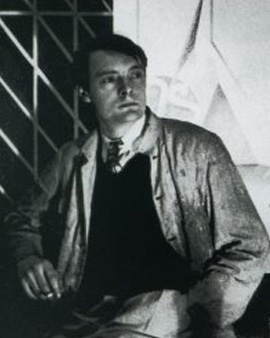Erik Ravilious was born in the town of Eastbourne in the county of Sussex, where his father ran an antique shop. After finishing school, the young Ravilious was able to study at the Eastburne School of Art with the help of a scholarship he won. He later moved to the Royal College of Art London, where he became friends with painters such as Edward Bawden, Douglas Percy Bliss and Henry Moore. The very talented and hard-working student even received a travel grant to Italy, where he visited Florence, Sienna and Tuscany and immersed himself in the art of the Old Masters. During this time the artist worked almost exclusively in watercolour. But he also created other works. In Eastbourne he had been a student of the famous artist Paul Nash. He often worked with wood engraving. He taught Ravilious in this technique and was so enthusiastic about his work that he promoted him and gave him orders again and again. Eric Ravilious illustrated books and articles and designed murals at Morley College, for example, which he worked on for a year with two fellow painters.
In 1930 Ravilious Eileen married Luzy "Tirzah" Garwood. She too was an artist and passionate engraver. The couple had the children John, James and Anne. The Ravilious couple also worked together in part. For example, they created together wall paintings in Art Nouveau at the Midland Hotel in Morecambe, which is well known from Agatha Christie films. In 1936, Eric Ravilious received an order from the porcelain and ceramic manufactory Wedgewood. For them, the artist created the design for commemorative cups, cups and various services. He also designed glasses, vases and furniture.
Br/>
In the 2nd world war the artist was appointed official war painter and was awarded the rank of honorary captain of the Royal Marines. Later he was in service with the Royal Navy. He painted ships in port and at sea, submarines, aircraft, military and civil installations and scenes of war. For example, he witnessed and recorded the bombing of the English Channel in 1941. He also learned to fly. On a reconnaissance flight to Reikjavik, on which he was a passenger, the plane disappeared without a trace. Ravilious and the other passengers were declared missing.
×





.jpg)
.jpg)
 - (MeisterDrucke-278621).jpg)
 - (MeisterDrucke-278621).jpg)
.jpg)
.jpg)
_-_(MeisterDrucke-257640).jpg)
_-_(MeisterDrucke-257640).jpg)
.jpg)
.jpg)
.jpg)
.jpg)
 - (MeisterDrucke-157280).jpg)
 - (MeisterDrucke-157280).jpg)
.jpg)
.jpg)
.jpg)
.jpg)
.jpg)
.jpg)
.jpg)
.jpg)
.jpg)
.jpg)
.jpg)
.jpg)
.jpg)
.jpg)
 - (MeisterDrucke-120218).jpg)
 - (MeisterDrucke-120218).jpg)
.jpg)
.jpg)
.jpg)
.jpg)
.jpg)
.jpg)
.jpg)
.jpg)
.jpg)
.jpg)
.jpg)
.jpg)
 - (MeisterDrucke-368706).jpg)
 - (MeisterDrucke-368706).jpg)
.jpg)
.jpg)
.jpg)
.jpg)
.jpg)
.jpg)
.jpg)
.jpg)
.jpg)
.jpg)
_-_(MeisterDrucke-591553).jpg)
_-_(MeisterDrucke-591553).jpg)
 - (MeisterDrucke-181892).jpg)
 - (MeisterDrucke-181892).jpg)
.jpg)
.jpg)
.jpg)
.jpg)
 - (MeisterDrucke-371851).jpg)
 - (MeisterDrucke-371851).jpg)
.jpg)
.jpg)
_officer_looking_through_the_periscope_Watercolor_and_pen_-_(MeisterDrucke-1501967).jpg)
_officer_looking_through_the_periscope_Watercolor_and_pen_-_(MeisterDrucke-1501967).jpg)
_-_(MeisterDrucke-119892).jpg)
_-_(MeisterDrucke-119892).jpg)
.jpg)
.jpg)
.jpg)
.jpg)
.jpg)
.jpg)
 - (MeisterDrucke-164128).jpg)
 - (MeisterDrucke-164128).jpg)
.jpg)
.jpg)
_-_(MeisterDrucke-598446).jpg)
_-_(MeisterDrucke-598446).jpg)
.jpg)
.jpg)
.jpg)
.jpg)
.jpg)
.jpg)
 - (MeisterDrucke-191197).jpg)
 - (MeisterDrucke-191197).jpg)
.jpg)
.jpg)
.jpg)
.jpg)
.jpg)
.jpg)
.jpg)
.jpg)
 - (MeisterDrucke-190101).jpg)
 - (MeisterDrucke-190101).jpg)
.jpg)
.jpg)
.jpg)
.jpg)
_-_(MeisterDrucke-547031).jpg)
_-_(MeisterDrucke-547031).jpg)
.jpg)
.jpg)
.jpg)
.jpg)
.jpg)
.jpg)
.jpg)
.jpg)
_-_(MeisterDrucke-556209).jpg)
_-_(MeisterDrucke-556209).jpg)
.jpg)
.jpg)
_-_(MeisterDrucke-1132557).jpg)
_-_(MeisterDrucke-1132557).jpg)
.jpg)
.jpg)
.jpg)
.jpg)
.jpg)
.jpg)
.jpg)
.jpg)
.jpg)
.jpg)
 - (MeisterDrucke-229262).jpg)
 - (MeisterDrucke-229262).jpg)
.jpg)
.jpg)
.jpg)
.jpg)
_-_(MeisterDrucke-1520122).jpg)
_-_(MeisterDrucke-1520122).jpg)
.jpg)
.jpg)
.jpg)
.jpg)
.jpg)
.jpg)
.jpg)
.jpg)
.jpg)
.jpg)
.jpg)
.jpg)
.jpg)
.jpg)
.jpg)
.jpg)
.jpg)
.jpg)
.jpg)
.jpg)
.jpg)
.jpg)
.jpg)
.jpg)
.jpg)
.jpg)
.jpg)
.jpg)
.jpg)
.jpg)
.jpg)
.jpg)
.jpg)
.jpg)
.jpg)
.jpg)
.jpg)
.jpg)
.jpg)
.jpg)
_-_(MeisterDrucke-1113080).jpg)
_-_(MeisterDrucke-1113080).jpg)
.jpg)
.jpg)
.jpg)
.jpg)
.jpg)
.jpg)
.jpg)
.jpg)
.jpg)
.jpg)
.jpg)
.jpg)
.jpg)
.jpg)
.jpg)
.jpg)
.jpg)
.jpg)
.jpg)
.jpg)






